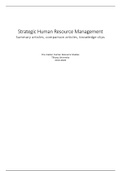Samenvatting
Summary Articles, Comparison Articles & Knowledge Clips
This summary seems large! However, since it summarizes in a clear and easy way what is highlighted in the articles, you will read really easy and fast trough it. The summary includes topics that are important for the exam. In addition to the summary articles, also a comparison between the articles ...
[Meer zien]





